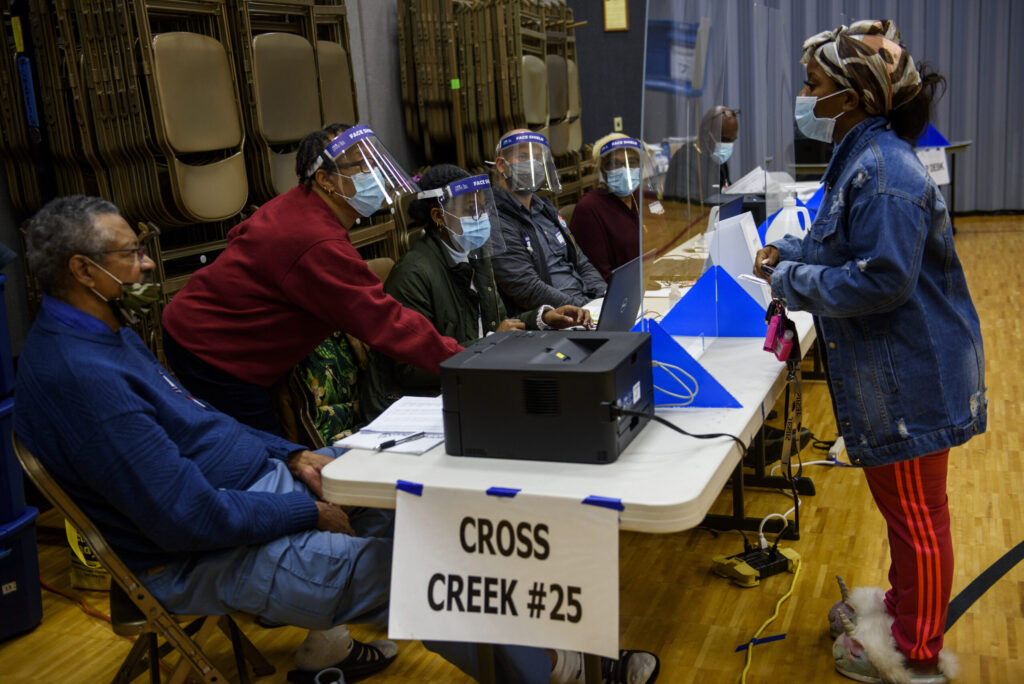Volunteers help a woman locate her correct polling place after being unable to locater her voter registration on Election Day at Church of Jesus Christ of latter-day Saints on November 3, 2020 in Fayetteville, North Carolina. Ahead of the election, up to one-fifth of voters in some Alabama counties, including 22.9% in Macon County, are listed as inactive. (Melissa Sue Gerrits/Getty Images)
With less than two weeks before the presidential election, some Alabama counties have up to one-fifth of their registered voters listed as inactive, largely attributed to outdated systems and difficulty in updating students’ voter registration.
Macon County, where Tuskegee University is located, had 22.9% of its registered voters listed as inactive as of September 2024, according to data from the Alabama Secretary of State, the highest percentage in the state.
In Tuscaloosa County, with the University of Alabama’s main campus, 14.61% of registered voters are listed as inactive. Auburn University’s campus is in Lee County, where 17.24% of its registered voters are listed as inactive. Greene County, which does not have a college campus, had about 7.5% of its registered voters listed as inactive. Most counties had less than 10% of their registered voters listed as inactive as of September.
GET THE MORNING HEADLINES.
Alabama’s voter registration has fluctuated over time, with a significant increase in inactive voters from 2020, when the state had 5.9% of its registered voters as inactive, to 10.8% in 2024. The state saw its lowest percentage of inactive voters in 2014, with 3.8%, which was a significant decrease from 2010 when the state had 11.8% of its registered voters as inactive.
The Secretary of State’s office says the number of inactive voters went from 225,166 in 2020 to 407,706 this year, an 81% increase.
Inactive voters can still vote on Election Day if they reidentify themselves in person to their local board of registrars before Election Day or complete a voter reidentification form when voting on Election Day.
Mitchell Brown, an Auburn University professor focusing on election administration, said the fluctuation in inactive voter numbers over time can be attributed to different factors such as varying voter interest and outreach efforts.
Brown said that during high-interest elections, such as those featuring particularly compelling candidates, many people who are not habitual voters may register to vote, which would contribute to an increase in the list of inactive voters if they don’t vote again in subsequent elections.
“There’d be lots of reasons for those numbers to go down, and some of it really is about people who aren’t regular voters, who might decide to register because they’re excited about a candidate that they want to vote for, and then in the next election cycle, there aren’t any interesting candidates on the ballot for them, and so they just don’t,” Brown said.
Turnout for the midterm elections in Alabama in 2018 was just under 50%, unusually high for a midterm. It reached nearly 62% for the 2020 presidential election, somewhat below what state officials had predicted. But it fell to 38.5% in 2022, as a weak statewide Democratic ticket dampened enthusiasm in the general election.
Leigh Reed, a registrar in Macon County, said that many voters, especially those registered at universities, remain on the inactive list without realizing it. Voters receive confirmation cards in the mail. If the card isn’t returned, the assumption is that the voter still resides at the registered address.
“We’ve got a bunch of people living that are registered on campus at Tuskegee University, that have been living in the same dorm room for — they’re now in their mid-40s,” Reed said.
Every four years, Alabama sends a voter confirmation mailing to every registered voter in the state. The cards that come back go out a second time. When voter confirmation mailings are returned to the Board of Registrar office as undeliverable, those voters are put on the inactive list until they confirm they are still living at the same address.
Kathy Jones, President of the League of Women Voters, also said that students frequently miss these mailings because they either don’t check their campus mailboxes or have moved off-campus. Relying on a paper-based system worsens this problem, as outdated addresses often stay in the system for years.
“If you look in Alabama’s laws, there’s a lot of pieces to this that state law says you shall publish your voting list in the paper. We don’t even have papers in a lot of counties anymore,” Jones said, adding that the outdated process can be costly to counties.
Brown said maintaining voter rolls involves putting voters on the inactive list, and the process isn’t necessarily done in bad faith.
“Inactive voter status exists to maintain clean voter rolls. If someone hasn’t voted in two federal elections, we send a postcard to confirm their address. If the voter doesn’t respond, they are marked inactive,” Brown explained.
She emphasized that while the term “purging” often causes concern and said the process is more about ensuring that voter rolls remain accurate and manageable.
Jones also said that although voters are marked as inactive, they can still vote by updating their information at the polls. The real issue lies in the system’s reliance on physical mail.
“The system is antiquated. Electronic notifications would be far more efficient in today’s world,” she said, pointing to potential positives, such as technology reducing human errors.
YOU MAKE OUR WORK POSSIBLE.

